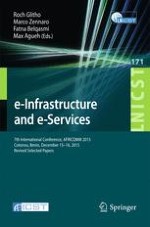2016 | Buch
e-Infrastructure and e-Services
7th International Conference, AFRICOMM 2015, Cotonou, Benin, December 15-16, 2015, Revised Selected Papers
herausgegeben von: Roch Glitho, Marco Zennaro, Fatna Belqasmi, Max Agueh
Verlag: Springer International Publishing
Buchreihe : Lecture Notes of the Institute for Computer Sciences, Social Informatics and Telecommunications Engineering
